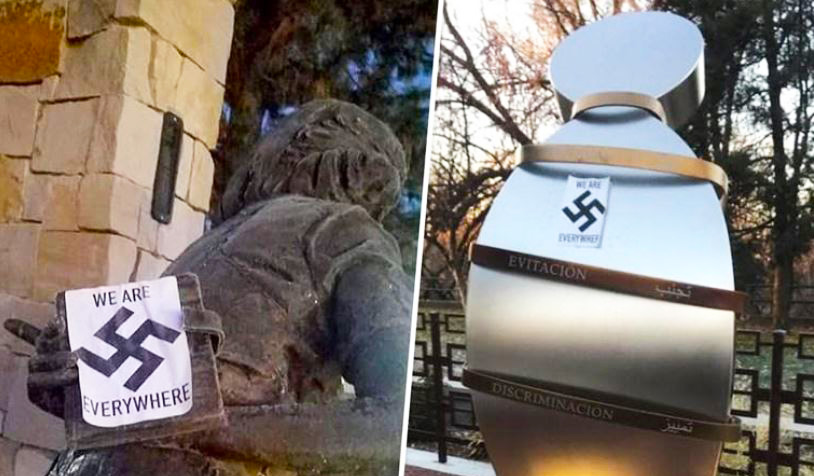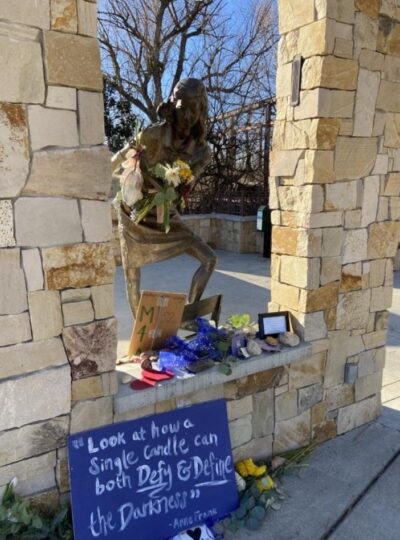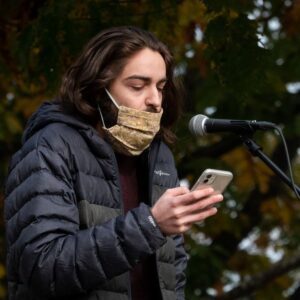In the past few months, sites across the Pacific Northwest have been vandalized with stickers featuring a swastika and the message “We Are Everywhere.” Earlier in October, neo-Nazis defaced downtown businesses in Bellingham, Washington with the stickers and the Anne Frank Memorial in Boise, Idaho was targeted in December.
While for some this vandalism just adds to a growing list of unfortunate antisemitic and racist acts echoing the incidences of hate taking place around the country, for me it was more personal. I witnessed both the places I’ve called home for the last fifteen years attacked by a campaign of fear and intimidation. Not only were the vandalisms close in time and geography, they also both featured identical stickers of Nazi propaganda.
I cannot ignore these two incidents. I can’t think of them as tragic coincidences.
BELLINGHAM: My College Town and Growing Community
On the morning of October 10th, Bellingham businesses found their windows defaced with the neo-Nazi stickers. Popular spots such as Village Books and Brandywine Kitchen were targeted, next to their painted affirmations that Black Lives Matter on their windows. Pedestrians and employees reported and removed the Nazi vandalism immediately.
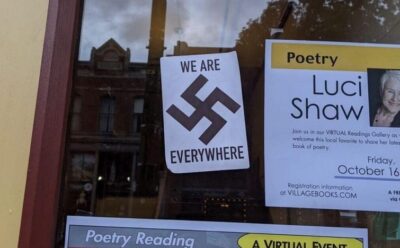
A week after the recent display of “hatred and intimidation” in Bellingham, the local Whatcom Human Rights Task Force (WHRTF) released a statement condemning this act of white supremacy. “The supremacist ideology that is being expressed and displayed cannot be allowed to take up space, intimidate people, and subsequently threaten the well-being of our entire community.” Over four-hundred people added their names to the statement.
Bellingham, where I have lived for the past three years, isn’t unfamiliar with such public acts of hate. As WHRTF also mentions, Bellingham and Whatcom county have a long history of white supremacy. The land that was originally colonially seized from the Coast Salish people would later also exclude Chinese and East Indian immigrants in the early 1900s. In the 1920s, Bellingham was a site for a dominant chapter of the Ku Klux Klan. WHRTF also notes the over one-hundred-year history of internments, sundown laws, fishing wars, and cross burnings. “More recently,” the organization states, “activity by the Proud Boys and the Patriot Front has increased throughout the County as well.”
Later in October, The Bellingham Herald was tipped about a white supremacist Instagram account which featured “racist rhetoric and showed a printing press making stickers exactly like the ones found Oct. 10 in downtown Bellingham and Fairhaven.” The Seattle ADL also told The Herald they believed it was the source of the Nazi stickers, and likely distributed them to the perpetrator of the crime. The account has since been deactivated by Instagram.
Elsewhere in late November, a Fairfax, California resident captured a video of a man walking around town in the middle of the day, plastering these same stickers while holding a roll of them in hand.
BOISE: My Family’s Hometown
As I was getting ready for the first night of Hanukkah, I heard of another tragically similar incident in Boise, Idaho where I had lived since I started middle school through my first two years of college. The day before, on December 9th, visitors at Boise’s Anne Frank Memorial awoke to the area plastered with nine of the same Nazi stickers. White supremacists had vandalized the diary on the Anne Frank statue, the face of Bill Wassmuth on one of the memorial’s infographics, and other places throughout the acre of the memorial.
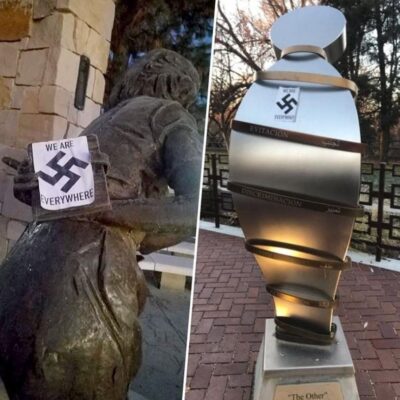
The Wassmuth Center for Human Rights was founded in 1996 and opened the Anne Frank Human Rights Memorial in 2002, the only one in the country. The Center’s namesake, Bill Wassmuth, was a notable human rights advocate that confronted the rise of the white supremacist Aryan Nation in northern Idaho. Though the Aryan Nation bombed his home, he never stopped his efforts.
“It’s a sad statement in our community to have such a public statement of hate,” said Dan Prinzing, the Center’s current executive director. Prinzing stated that he’s thought a lot about the vandalism’s direct and simple message, “Proudly proclaiming, they are everywhere. They are here. Well, then we do have to question: what is the moral fiber of our community? Where are we at the core?”
The similarity of these events from Bellingham to Boise, as well as the context of both places historical and contemporary relations to white supremacist activity, should bring a higher level of focus and scrutiny to how these ideologies and attacks are fermenting in the places we call home. It should also prompt white people, who may be disturbed but are not implicated by such acts, to ask themselves how they should respond to such incidents to move toward solidarity, compassion, and care for everyone in our communities.
BEARING WITNESS: My Communities’ Responses
Despite their horrific targeting, the people of Bellingham and Boise made sure that the Nazi defacements weren’t the only message heard. On October 25th a coalition of Bellingham organizations, such as WHRTF and Whatcom Peace & Justice Center, organized an event called “Show Up For Love Whatcom County.” The solidarity rally, at the Arch of Healing and Reconciliation across from Bellingham City Hall, brought out over one-hundred members of the community despite the frigid and cold Autumn day.
The event started with a lineup of local speakers, including Robert Lashley, a local poet; Terrance Morris, a community social justice speaker; Bill John, a member of the Lummi Nation; as well as myself. Afterwards, organizers initiated a community conversation by breaking up the crowd into socially distanced groups across the Lee Memorial Lawn, discussing how to confront organized racist attacks, and how to keep moving forward to create solutions together, from the bottom up.
Eve Smason-Marcus, one of the organizers with the WHRTF, told Western Washington University’s student newspaper that the discussions were meant to inspire, foster change, and develop a sense of safety and solidarity within the community. “When you have someone, who is masked and flyering in the middle of the night, how do you stop them?” Smason-Marcus said. “And I think there are a lot of creative solutions that deserve being talked about and formed as a community.”
In Boise, after the police removed the stickers from the Anne Frank Memorial, a Boise resident quickly replaced the vandalism of the statue with a bouquet of flowers and a note stating, “We are everywhere, we choose love.” They shared it on their Twitter with the simple caption: “Fixed it.”
When I flew into Boise for the holidays, my mom insisted we take my younger siblings to the memorial. Even my little brother, who like many middle school boys, usually stayed in his room to play video games was eager to go. He surprised my mom by taking pictures of the memorial, and later posting them on his Instagram. The day before Christmas Eve we walked throughout the memorial, all of us silently taking in stories and wisdom of the memorial’s stone-etched quotations. At the statue, we saw an assortment of beautiful flowers, painted stones, and messages of support and love repurposing the vandalism’s words that “we are everywhere.”
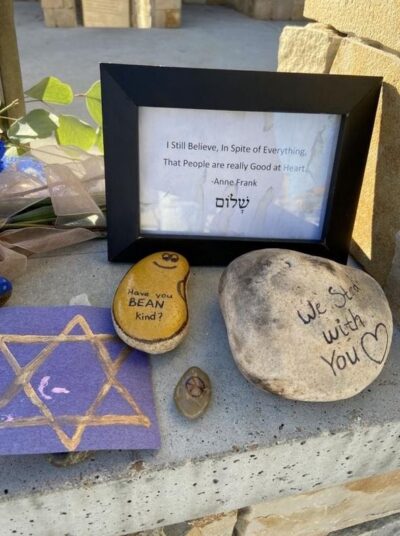
“We are going to own that narrative, that love and compassion are louder than the voices of division and hate.” Dan Prinzing adds, “While we cannot physically stand together, we can each stand up in our homes, our neighborhoods, places of worship, where we work, our schools, to stand up against injustice. It starts there.”
Communities should heed Prinzing’s words: “When you hear it, when you see it, don’t be silent. Stand up.”
Reflections on the Storming of the Capitol
The United States has arrived at a moment of reckoning as similar incidents have continued into the new year. On January 6th, people around the world watched as Trump supporters, white nationalists, and neo-Nazis stormed the US Capitol shutting down Congress’ certification of President-elect Joe Biden’s victory.
Confederate flags, erected nooses, and Nazi paraphernalia such as shirts featuring slogans such as “Camp Auschwitz Staff” and “6MWE” (6 Million Wasn’t Enough) were all present as rioters were let inside the Capitol building.
The country bore witness to the intensified radicalism of racists, antisemites, and the like. American Jews can no longer think that these acts are few and far between, or by only a handful of deranged individuals. This is white supremacy in full mobilization, and it’s not just affecting us.
People can no longer simply share news articles on our social media when events like these happen. Because they have and will continue to – no amount of virtual conversations and debates will stop this wave of right-wing radicalism. We have to do that ourselves.
American Jews, particularly white Jews, have to organize, protect, and build community with Black, Brown, and Indigenous people, and of course Jews of Color, who have always been and remain unsafe in this country. We have to look to understand how anti-Black racism, white settler colonialism, antisemitism, xenophobia, and other systems of oppression are intimately interconnected. We have to stand and work together to confront this wave of white supremacist organizing.
As Whatcom Human Rights Task Force is preparing for its 23rd Annual Reverend Dr. Martin Luther King Jr. Human Rights Conference, I along with many in the Bellingham community, have been reflecting on King’s words and revolutionary spirit.
King reminds us, “Every step towards the goal of justice requires sacrifice, suffering, and struggle; the tireless exertions and passionate concern of dedicated individuals. Without persistent effort, time itself becomes an ally of the insurgent and primitive forces of irrational emotionalism and social destruction.”
May we all strive to embody King’s words: “The ultimate measure of a [person] is not where [they stand] in moments of comfort and convenience, but where [they stand] at times of challenge and controversy.”
King’s words reminds me of the wisdom and moral duty Rabbi Hillel articulates in Pirkei Avot 1:14 – “If I am not for myself, who will be for me? But if I am only for myself, what am I? And if not now, when?”
